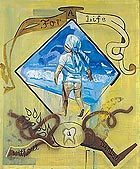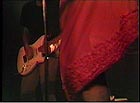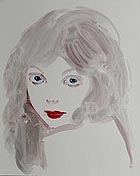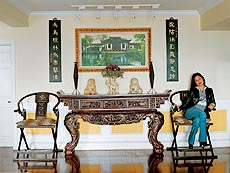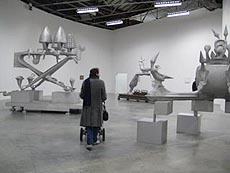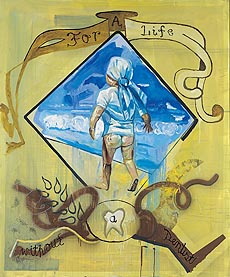
translated and summarized by: Liz Wollner-Grandville,
November 11 - 26
Kunsthaus Graz: Model Martin Kippenberger - Utopias for everyone
Projection-screen artist
Martin Kippenberger`s exhibit in Graz , curated by Peter Pakesch, is decisively influenced by the close relationship between Kippenberger and the former gallery owner Pakesch. The artist, who died ten years ago, also had a very special connection to Graz. He spun a huge network of friends during the long time he spent in this city. In the 80s, the Forum Stadtpark was a breeding ground for Kippenberger's contacts and partnerships.
It is impossible to separate Kippenberger as a person from his art as a commodity, his character and his work are much too closely knit. He can be characterized as one of the last Bohemians of the 20th Century - practically living in cafés and bars and always being the centre of attention. He was able to transform his personal matters into topics of general interest . Pre-eminently he addressed the myth of the art-star and enjoyed playing with this idea.
The pieces selected for this exhibit are a retrospective - his art work is presented chronologically from the beginnings until his death. However, there is no obvious reason to stress the word "Utopia" for the umpteenth time. His work ranges from painting, illustration, sculptures to poster-art.
Kippenbergers sketches and illustrations are very impressive and offer an enhanced insight into the works shown. They are proof of the nonchalance in which he tackled topics, ideas and projects. Was it coincidence or a conscious move to place the oil painting "Congenial Female Communist" (1983) across from the interlinking and permeating "Metro Net" (1993 - 1997/2003) at the starting point of the exhibit tour? In any case it offers a beautiful overview of the variety of Kippenberger`s Oeuvre.
The posthumous exhibit of this work at the Biennale in Venice in 2003, the displays of his work one decade after his death , which are now considered a real hype - Kippenberger has, like so many others before him, become famous after his death, and extremely successfully so.
(8020 Graz, Lendkai 1, until 16. December 2007)
www.kunsthausgraz.at
Ausstellungsräume der Akademie der bildenden Künste: Branko Andric
In line with art. On the verge of politics
The heart is in the right place
The title of Branko Andric`s first book of poetry, published 1972 in ex-Yugoslavia was "I`m mom`s little sexual". The artist`s motivation to achieve a change of attitude among the members of the increasingly black-and-white society was to be provocative in a positive way. Andric simultaneously worked and lived in a variety of surroundings. He fuelled his art by leaving nothing untouched. Who was the type of person who loved everyone, because he loved mankind, but who had also experienced the abysm of a relationship. Andric was born 1942 in the multi-ethnic province of Vojvodina and died 2005 in a car accident on his way from his beloved second home city Vienna to Novi Sad. As a mediator of social-cultural content he was both a painter and illustrator as well as a musician and author. Film as well as performance was also part of his artistic spectrum.
The central motif of his artistic work was the frame. His audience, onlooker or simply the coincidental parties involved should always feel comfortable. They should not be instructed to rethink or think about his work, it is meant to have a lasting effect on them. Andric never considered himself to be a political activist, but he used the framework of art as a kind of connection-valve. Whoever wishes to see this successful exhibit of a warm-hearted Mensch, which was organized under the patronage of his son, should begin his eclectic voyage with the different nuances of blended paint. 'There might be less boundaries, but those of the mind are increasing': This is what Andric wanted to convey.
(1010 Wien, Schillerplatz 3, until 2. December 2007)
www.akbild.ac.at
Galeria Antonio Ferrara: Annie Kevans - Vamps & Innocents
Face and Character
The archetypal steady gaze of a male at love, eroticism, and a body is still a dominating model - even in today`s globalized society. After the First World War Hollywood films took over the task of holding on to this gaze for the masses: the picture of a woman was transformed into a sensual fetish. The central theme of Annie Kevan`s work is the "self confident femininity", an attribute initiated through silent movies. Parallel to Kevan`s exhibit in Munich, she is presenting her most recent series of paintings in a solo exhibition in Vienna.
Rarely is a newly discovered foreign talent - Kevan`s home is London - invited to Vienna. But doesn`t Vienna offer a special historical reference to the painting of an actress? Didn`t the Viennese actresses take on the roles of innocent creatures in the numerous cinematographic melodramas and social dramas, while being vamps in real life? Kevan`s portraits of these extremely young silent movie starlets are all depicted in exactly the same way as they were conveyed by Hollywood films: instead of entrusting women with important character roles they were simply and irrevocably classified into types, according to their character. Annie Kevan took up two of these characters: the whore and the virgin.
Kevan`s empathetic and deliberately not perfect paintings of young actresses, such as Betty Love, Lillian Gish or the declared film icon Louise Brooks, are not quite as innocent as they pretend to be. In some cases the plain background underlines the dainty aura of the at times audacious and cheeky looking starlets. Paintings in which the poignant look of the young women, who seem to glance at the viewer in a conspiratorial way, stand out most.
Often times unfulfilled wishes and traumas are hidden behind these seductive glances full of longing. Nearly every biography of these selected "new women" will reveal the sudden end of their film career. None of them were able to put their own personality into effect on screen. Nonetheless these "dashing young girls", their outfits, gestures and silent emotional games changed the male`s gaze and thereby also part of western history - directing it towards female emancipation.
(1060 Wien, Otto Bauer Gasse 11, until 21. December 2007)
www.antonioferrara.com
Architekturzentrum Wien: Chinaproduction
Plethora of images
The media all around the world are intently addressing China and producing one cliché after the other: masses, Mao, power, fast deals, and investor`s projects reaching record-highs in breakneck speed - just to name a few. A vast number of star architects are implementing projects in China. Their numbers are just as humungous as the speed and variety in which they are built. "An era In China changes every two years. It could be compared to an instantaneous water heater of world-architecture", Dietmar Steiner, Director of the Architekturzentrum Wien (AzW) summarizes China's recent development.
'Chinaproduction' was curated by Johannes Porsch and he displays the architectural work as a kind of reflection to the photos and media coverage it evokes. The different topics are grouped kaleidoscopically and mounted on hanging backboards referring to one another and thereby forming a kind of "China puzzle". This ranges from the search for a specific identity, a partly utopian urban vision of the future to the basic problems faced by the property rights or conditions of architectural production.
Aspects of the Chinese reality are presented like parts of a broken mirror, mainly focusing on the interest of the media, and - depending on the media`s viewpoint - history and ideological change also play a role. Both the national icon such as the Forbidden City as well as former identity-establishing relicts of the Mao-era or classic modern Chinese reference models, which could be seen anywhere in the world, are integrated into this exhibit. How turbo-capitalism and turbo-speed affect individual living conditions, is vaguely perceptible through Miao Xiaochun, Hu Yang and Xing Danwen`s photos.
"One can get lost here and that is very Chinese": Jerome Rocherolle`s quote is positioned over a picture of a landscape immersed in fog. Chinaproduction, if seen this way, is definitely very Chinese. One can easily get lost between the text blocks and pictures. But one can also discover many new things. The viewers involvement will depend on the China-image, which he moulds to fit his own vision. And in the publication "Hintergründe" (Backgrounds) this vision could easily be amended.
(1070 Wien, Museumsquartier, Museumsplatz 1, until 21. December 2007)
www.azw.at
Palais de Tokyo: The third mind
Carte Blanche
In the October edition of "Frieze" Robert Storr, the former MOMA-curator, Director of the Venice Biennale and current Dean of the Yale University Art Department, criticizes that many top positions in the exhibition business are filled with technocrats instead of creative visionaries. Raising funds as well as contacting sponsors have become the key tasks of museum directors. These aspects also played a role in the decision to appoint the Swiss Olivier Wahler as the head of the Palais de Tokyo in 2006. Lets come to the point: if the head is not a visionary, not every exhibit has to be compiled by the administration. There is no longer any reason to be afraid of "outsourcing the core competence". And this, as one can see with the current exhibit, can be a huge advantage. Wahler, preoccupied with questions of finance and budgeting, hands the task of curating on to friends in the art-world. The current show is curated by his Swiss friend Udo Rondinone and it has turned out to be one of the best exhibits of the Palais de Tokyo. Part of this success is probably ascribed to the fact that Rondinione does not have to churn out one exhibit after the other. His personal dedication and leisurely approach to the topic presents us with surprising arrangements and discoveries. Rondinione selects items from his own collection and thereby points to his wide artistic spectrum.
This title of the exhibit "The third mind" is borrowed from a book by the Beat authors William S. Burrough and Brion Gysin, however, the publication never got off its feet. One can view their rare "cut-ups"- text and picture collages.
Rondinione works his way from room to room and creates an atmosphere best described as "differently temperate". He combines the work of two or three artists into so-called 'environments', which function like a chapter within the exhibit:
Bruno Gironcoli`s monumental bizarre sculptures come upon Sue William`s fragile, small formats. 92 empty waiting rooms in railway stations painted by Jean Frederic Schnyder encounter Andrew Lord`s baroque ebullient ceramics. A selection of Warhol`s Screen-Test Factory Friends (among them Edi Sedgwick, Lou Reed and Marcel Duchamp) silently and sometimes inquisitively stare at you from screens and thereby perfectly match the Camera-obscura "Starfinger Angel" by Bruce Connor. One space is dedicated to Joe Brainard, who created nostalgic colourful kitschy collages before he decided to quit his career as an artist and devote his time solely to reading. Paul Thek`s amazing sculptures and the carefully illustrated ornaments by Emma Kunz form the most impressive room of the exhibit. The works of 31 artists are displayed at the Palais de Tokyo and Rondinione succeeded in creating a fascinating array of impressions, something not seen often. His project is most enjoyable and one would hope to see it at many different venues.
(75116 Paris, 13 Avenue du Président Wilson, until 3. January 2008)
www.palaisdetokyo.com
Mehr Texte von translated and summarized by: Liz Wollner-Grandville


 Teilen
Teilen

